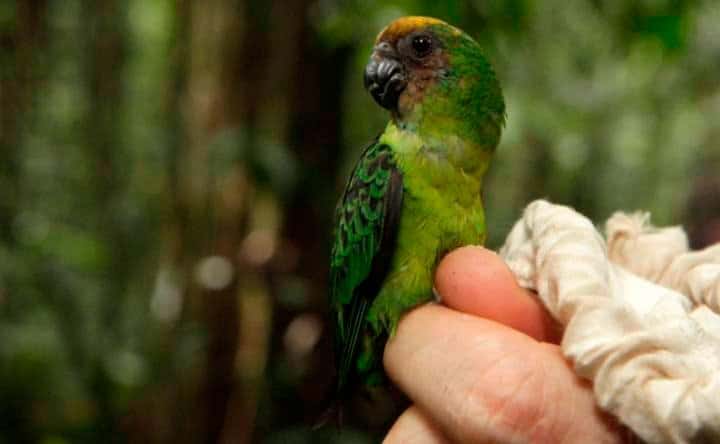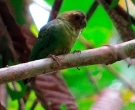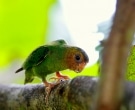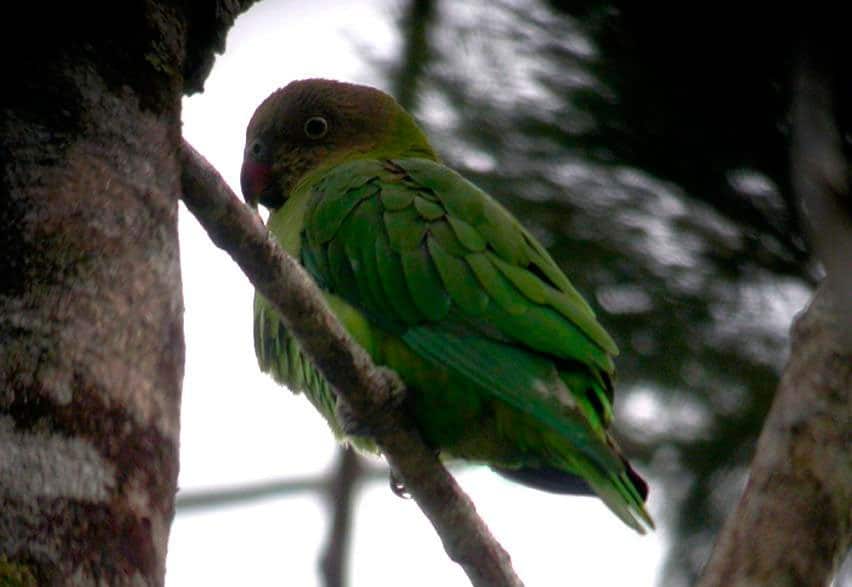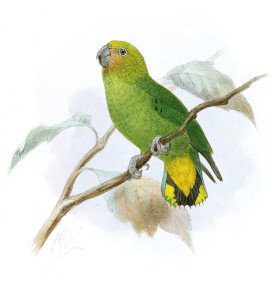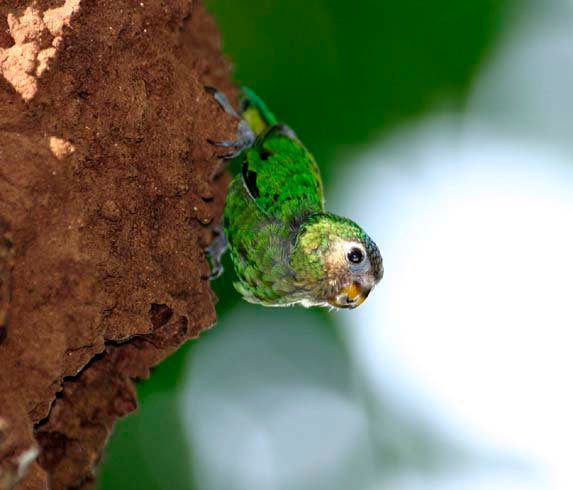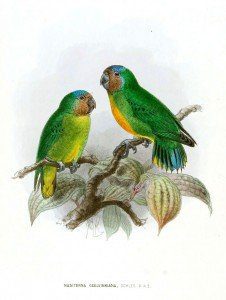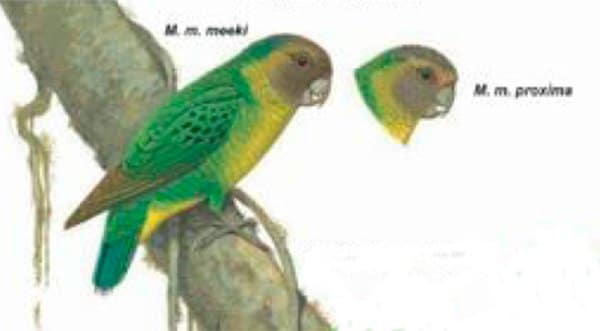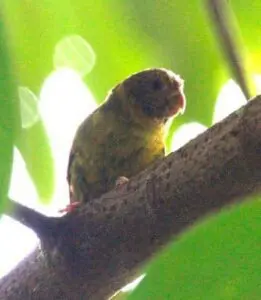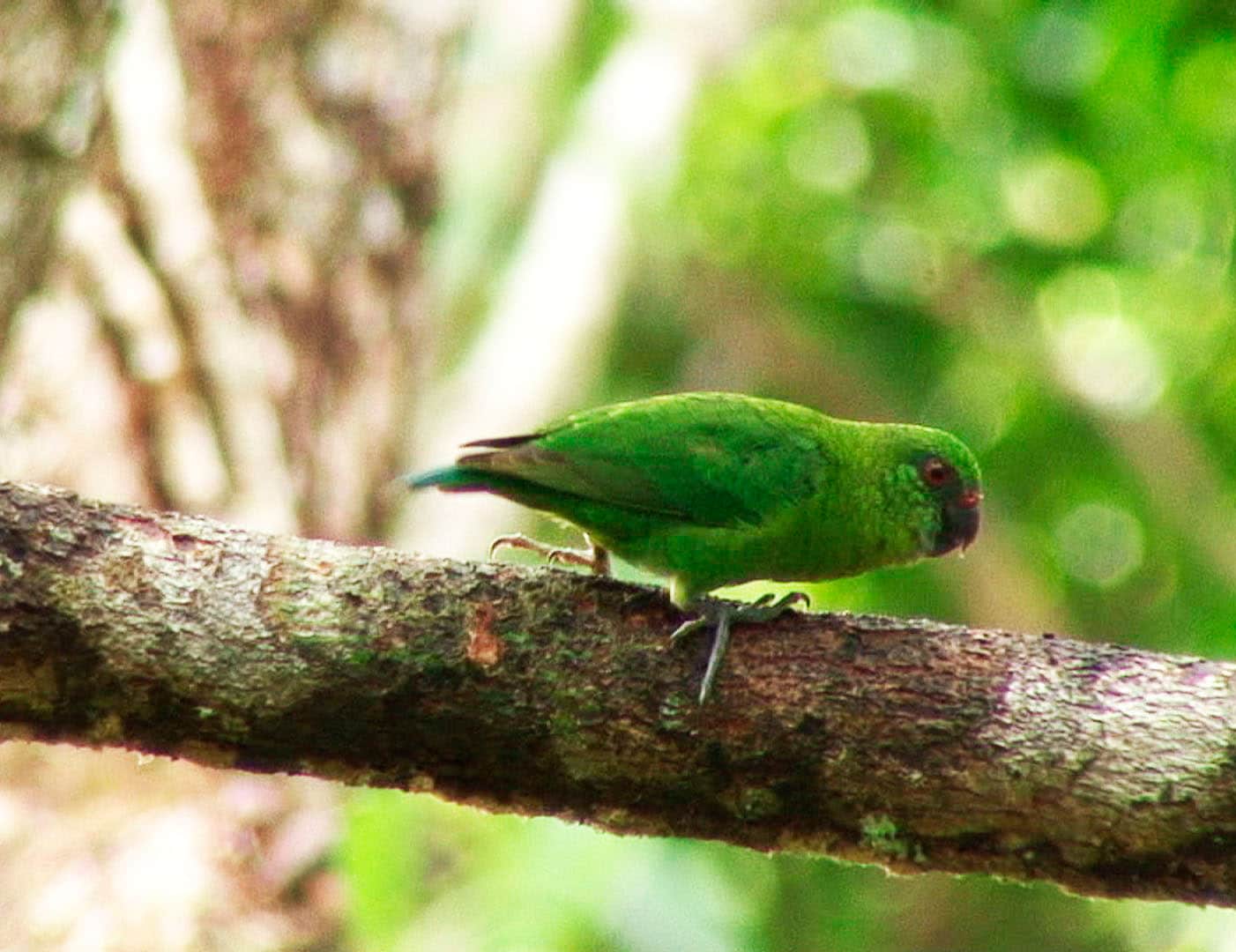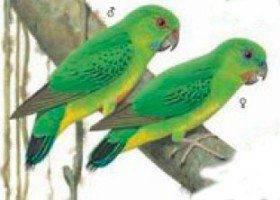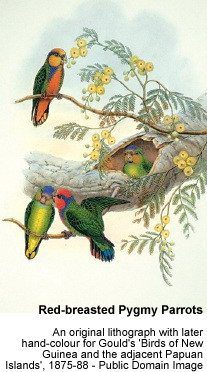Content
|
|---|
Description
The Buff-faced Pygmy-Parrot (Micropsitta pusio) has a length 8,4-8,6 cm.. and 11,5 g. of weight, what it becomes in the Parrot more small of the world.
Has the forecrown, face and chin of color Brown mottled dark, eyebrows yellowish; centre of crown blue, merging to green in the area of the nape. Upperparts Greens with wing-coverts Black in the Center. Flight feathers Black with green ends; lower coverts greenish yellow; underside of the primaries greyish, lightly bathed in yellow. The underparts brighter yellowish green, more pale in the center of the chest and the belly; uppertail-coverts Yellow. The tail centrally blue, with a black shaft. Outer feathers Black with yellow spots.
Bill dark grey; irises brown; legs of color grey or pink.
Female slightly more off than the male around the face.
Young with crown greenish blue and less brightness in the face.
- Sound of the Buff-faced Pygmy-Parrot.
Subspecies description
-
(PL Sclater, 1866) – Nominal
Micropsitta pusio pusio
-
(Salvadori, 1876) – Usually darker than the nominal race especially on the face, including eyebrows.
Micropsitta pusio beccarii
-
(Mayr, 1940) – Brands that most off the nominal head, Blue throat. Less yellow in the parts below that the subspecies Micropsitta pusio stresemanni.
Micropsitta pusio harterti
-
(ECTION Hartert, 1926) – As the subspecies Micropsitta pusio harterti, but slightly larger and more yellow below.
Micropsitta pusio stresemanni
Habitat:
They are found in lowland forests, wooded hills, gallery forest and secondary vegetation, from sea level to the 500 m. It is also locally in the Savannah and areas of coconut trees (Cocoa nuts).
The species is common and trusting, but can be hard to find due to its small size. Birds can also sometimes be glimpsed by flying in small groups above the canopy. They tend to fraternize in pairs or in groups of up to 30 birds.
They frequently stop while they feed on and turn your head to the right, possibly to find predators.
Reproduction:
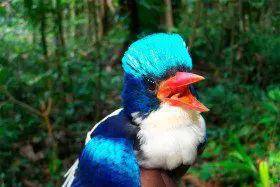
Nestbox, they dig in tree cavities active termite mounds, for example the (Microcerotermes biroi). A nest was also found in a terrestrial termite, the entry just a meter from the ground. There is a flange on each side of the entry hole and this differentiates their holes of other species that make their nests in termite mounds, such as the Common Long-tailed Kingfisher (Tanysiptera galatea).
Until three white eggs are the implementation. The nesting season has been recorded throughout the year. Adults sleep on community and up to eight birds have been recorded from a cavity.
Food:
It moves rapidly along lianas and trunks or branches of trees (in inverted position) using its long claws to grip and digging lichens and fungi in the barks. Also sometimes feed on seeds, fruits and insects (that it can be accidentally ingested).
Distribution:
Lowlands of North of New Guinea from the West coast of the bahía Paradise, Irian Java, at the Southeast end of Papua New Guinea; absent from the Highlands of the Huon Peninsula and Owen Stanley Ranges above each 500 m, but observed in some of the Northern Islands of New Guinea, including Kairiru, the Schouten Islands, Manam, Karkar and Batangas. The species is found in the lowlands of the West to the coastal region of South on the Purari River. Are also in the Bismarck Archipelago, including Umboi, Tolokiwa, Sakai, the Witu Islands, Lolobau, New Britain, Uatom and Duke of York. Also observed in the d'Entrecasteaux archipelago in Fergusson and in the Louisiade archipelago in Misima Island and Tagula.
Subspecies distribution:
-
Southeast New Guinea and Bismarck Archipelago
Micropsitta pusio pusio
-
North New Guinea, Manam, Karkar, Batangas and Rook islands
Micropsitta pusio beccarii
-
Fergusson Island. (D'Entrecasteaux Archipelago)
Micropsitta pusio harterti
-
Louisiade Archipelago (Misima Island and Tagula)
Micropsitta pusio stresemanni
Conservation:
• Current IUCN Red List category: Least concern
• Population trend: Stable
The size of the world's population has not been quantified but he is estimated above the 100 000 specimens.
The species according to sources is very rare in its range distribution.
The population suspected to be stable in the absence of evidence of any reduction or substantial threats.
"Buff-faced Pygmy-Parrot" in captivity:
They feed on lichens and fungi., therefore its reproduction and maintenance in captivity it is virtually impossible.
Alternative names:
– Buff-faced Pygmy-Parrot, Buff faced Pygmy Parrot, Buff-faced Pygmy Parrot (ingles).
– Micropsitte à tête fauve (French).
– Braunstirn-Spechtpapagei (German).
– Papagaio-pigmeu (Portuguese).
– Microloro de Cabeza Azul, Microloro Pusio (español).
scientific classification:
– Order: Psittaciformes
– Family: Psittaculidae
– Genus: Meeki
– Scientific name: Micropsitta pusio
– Citation: (Sclater,PL, 1866)
– Protonimo: Nasiterna pusio
Images “Buff-faced Pygmy-Parrot”:
Videos "Buff-faced Pygmy-Parrot"
————————————————————————————————
“Buff-faced Pygmy-Parrot” (Micropsitta pusio)
Sources:
– Avibase
– Parrots of the World – Forshaw Joseph M
– Parrots A Guide to the Parrots of the World – Tony Juniper & Mike Parr
– Birdlife
– Photos:
(1) – El loro más pequeño del mundo – medioambiente.net
(2) – Photo of Micropsitta pusio [By Katerina Tvardikova] – New Guinea Birds
(3) – A bird feeding on the bark of a tree. Author Carmelo López – lynx
(4) – Photo of Micropsitta pusio [By Katerina Tvardikova] – New Guinea Birds
(5) – Buff-faced Pygmy-Parrot, Micropsitta pusio at Nimbokrang by jon hornbuckle – BIRDING AROUND THE WORLD
(6) – Tanysiptera galatea By Katerina Tvardikova – New Guinea Birds
– Sounds: BAS van Balen (Xeno-canto)
